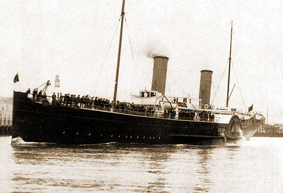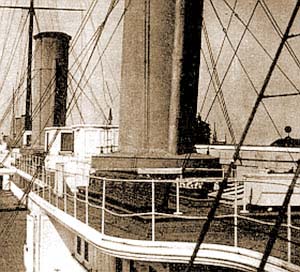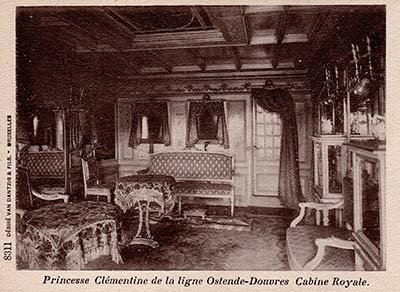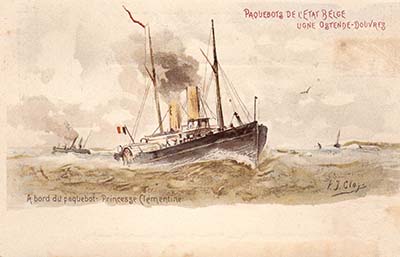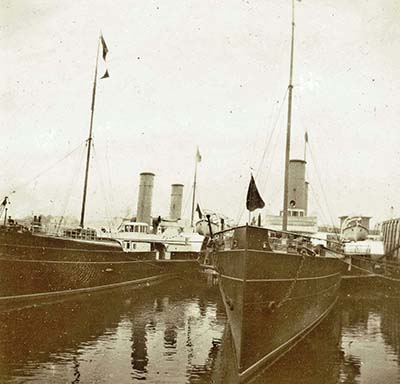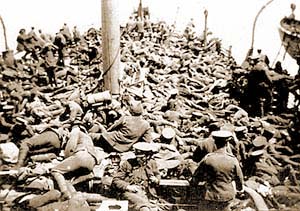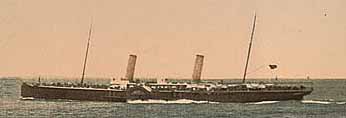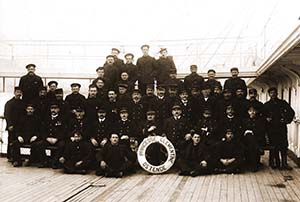Niet lang na de lancering van de Rapide besliste men al om een nieuw schip aan de vloot toe te voegen. Het contract werd al op 3 december 1895 door de Minister getekend en goedgekeurd en Cockerill kon de bouw ervan in de wacht slepen. Het schip kreeg bouwnummer 352.
Men wilde een volledige moderne vloot. Op dat moment was het nog enkel de Prince Baudouin van de oude generatie in dienst dat enkel als reserveschip dienst deed. De reputatie van snelste lijn ter wereld met het grootste comfort diende toch in stand gehouden.
Het nieuwe schip zou naar model van de Marie-Henriette worden gebouwd met accent op luxe en technische verbeteringen. Ze krijgt een lengte van 103.629 meter en 11.582 m breed. De totale breedte zou 24 meter bedragen over de tamboers gemeten. Tijdens de bouw besliste men om het schip “Princesse Clémentine” te noemen.
In het contract stonden de voorwaarden opgesomd dat voornamelijk aandacht had voor de snelheid van het vaartuig. Wanneer het schip in Oostende geleverd werd volgens de normen van het contract (bestek) was een duidelijke voorwaarde voor de snelheid voorzien. Indien de snelheid bij de test lager dan 21,75 knopen zou bedragen dan zou de som van 125 000 Fr. in mindering worden genomen voor elke knoop dat het schip trager zou zijn. Indien een hogere snelheid dan 21,75 knopen zou gehaald, was een supplement van 222 250 Fr berekend per behaalde knoop hoger dan de opgelegde snelheid en met een maximum van 100 000 Fr. Dat wilde zeggen dat Cockerill een snelheid van 22,2 knopen op de test diende te halen om die som van 100 000 Fr. te worden uitbetaald.
In het contract stond ook duidelijk dat de testen tussen 10 en 25 maart 1897 moeten doorgaan. Indien vertraging zou de som van 1000 Fr per dag vertraging na 25 maart worden aangerekend. Het schip moest niet later dan 1 mei 1897 in Oostende worden geleverd. Indien vertraging zou tevens 1000 Fr. per dag worden aangerekend tenzij overmacht kon bewezen. Na de levering in Oostende werd een waarborg van zes maanden voorgeschreven en tevens ook de voorwaarde om tijdens die periode door de constructeur één man aan boord op hun kosten te voorzien.
Het schip liep van stapel op donderdag 22 oktober 1896 om 15u30. Prins Albert van België was aanwezig en wilde vooral geen gala of grootse ceremonie. In de krant “Le Carillon” van 25 oktober 1896 vinden we een beschrijving van het verloop van de stapelloop.
“Deze tribune is bedekt in Antwerpse kleuren en versierd met kleine driekleurige vlaggetjes. We merken een groot aantal dames waaronder ook de meter van het schip Mm Greiner, de echtgenote van dhr Greiner, directeur. We zien ook dhr Greiner, Mr. Crets; Mr. Kraft, ing te Seraing, Mr Francois, Mr Fred Kraft (zoon) en Mr Ortmans, chef van het departement Transport Antwerpen. Tussen de hoge functionarissen citeren we Mr Allo en Verbrugghe, elg. Directeur; Mr Lecointe, chef ir. ; Mr Pierre, chef inspecteur te Oostende ; Em. Wauters, maritiem comm. Antw. ; Mr Roger, directeur Loodswezen Antwerpen ; Mr Pierrard & Moulin , ir Zeewezen. Rond het schip vele werkmannen die onder leiding staan van de heer Rickard, de ingenieur van Cockerill die de maritieme constructies begeleid. Er worden nog enkel onderdelen weggehaald en voorbereidingen getroffen. Het is 10 voor 4. Plots geeft Mm. Greiner een hak met de bijl en het koord is doorgesneden. Niets houd het schip nog tegen om te glijden en langzaam komt er beweging in. Al snel drijft de nieuwe pakketboot onder bevel van de kapitein van de Cockerill werf. Dit grote spectakel word onthaald op een groot applaus van de toeschouwers. Kort na deze verlaat men de werf en de wagens rijden in de richting van het Restaurant Colon waar de Cockerill werf een banket aanbied. Het is de Prins Albert die voorzit en het woord aan mevrouw Greiner geeft. Bij de toast drinkt mevrouw Greiner op de Koning waarop de Prins het glas heft op de Cockerill werf en zijn goede toekomst. De Prins verlaat Antwerpen om 18u30.”
Later publiceert “Le Carillon” van 6 december 1896 een mooie beschrijving van het schip als volgt:
“De nieuwe pakketboot voor de Oostende-Dover lijn dat de Staat bij Cockerill heeft besteld is klaar en kan in regelmatige dienst worden gezet. De nieuwe maalboot is van hetzelfde type dan de Marie-Henriette. De lijn is op alle punten gelijk en de installaties zeer opmerkelijk. Ze verschillen slechts op enkele details in het voordeel van het nieuwe schip. De romp van het schip is in staal. Ze heeft drie dekken, een wandeldek voor de reizigers, Op het binnendek is een lengte van 120 voet gereseveerd voor de machines en boilers. Er zijn zeven brandstoftanks met een capaciteit van 100 ton. Vooraan tussen twee bunkers een compartiment van 14 voet gereserveerd voor de bagage. Het ook in dit deel van het schip dat de ruimte voor 2e klasse reizigers zich bevind. Achter de ruimte voor de machines zijn er twee salons voor 1e klasse. Op dit dek bevinden zich ook de hutten voor de mecaniciens en matrozen. Op het tussendek zijn buiten de zone voor de machines ruimten voor de reizigers. Een overdekte promenade, toiletten, een restaurant en logement voor de onderofficieren. Op het hoofddek bevind zich in een speciale constructie, een rooksalon en hutten 1e klasse. Ook op dit dek de Koninklijke hut en de speciale hutten.”
Cockerill heeft een snelheid van 22 ½ knopen gegarandeerd en ontvangt een premie van 50 000 Fr. per knoop dat het schip sneller kan. Voor de Marie-Henriette heeft ze een premie van 100 000 Fr. gehaald. We denken niet dat het schip kan geleverd in de maand mei 1897. De premie dat Cockerill met de Princesse Clémentine kan halen is 10000 Fr. per tiende knoop of 50 000 Fr per knoop hoger dan opgelegd." (noot in het contract staat anders vermeld)
Het vermoeden van de late leverdatum was een beetje onterecht. Op donderdag 11 maart 1897 hadden er al eerste testen plaats op de Schelde in Antwerpen. Er waren weliswaar nog geen platen op het rad aangebracht om de motor te testen. Deze verliepen echter zeer goed. Een grote week later werden opnieuw testen gedaan ditmaal met de schoepen aan het rad. Het was slecht en stormachtig weer maar de testen waren een groot succes en voldeden aan de opgelegde normen in het lastenboek.
Om maar een indruk te geven aan de pracht op het schip publiceert de “Echo d’ Ostende“ op 23 maart 1897 een volgend artikel over de aangebrachte kunstwerken:
“De nieuwe maalboot Princesse Clémentine van onze overzetdienst Oostende-Dover zal in de lente van van dit jaar in dienst komen. Ze zal nog luxueuzer zijn dan de andere Belgische maalboten en versierd met aquarellen, schilderijen en keramiek.
Het departement van het Zeewezen heeft voor de vier luxe hutten aan elke zijde van de maalboot, twee reeksen van 8 aquarellen van de Gentse aquarellist A. Heins besteld die ze pas heeft afgewerkt. Deze aquarellen zijn één vierkante meter ongeveer en beelden Belgische zichten af zoals de ruines van Abbayede Villers, de vijvers van Rouge-Cloitre uit Groenendaal, de vallei van Biesmolle te Thuin, de poort van Tongeren, de ramp van Promenoire van de Schelde uit Antwerpen, de dijk van Malines met zicht van Herbeumont, van Laroche, het kasteel van Laarne, de Dender van Grammont, de rotsen van Dinant, een zicht uit Brugge, de waterval van Loo, de vestingen van Ieper, en het kasteel van Walzin.
Het rooksalon zal versierd zij met elf oliewerken van de Brusselse artiest Mr. G. Van der Hecht en oude steden uitbeelden.
Uiteindelijk zal de eetzaal van de nieuwe maalboot versierd worden met portretten in keramiek van 24 bekende zeelieden.”
Op 3 april 1897 ondertekenden de functionarissen van het Zeewezen samen met commandant Romyn het Proces Verbaal waarbij ze verklaarden dat het schip conform het lastenboek was gebouwd.
Uiteindelijk diende men nog de aandacht te geven aan de officiële testen die net zoals alle andere nieuw gebouwde schepen moest doorgaan op de Clyde in Schotland. Men had al in de avond van zondag 5 april de vuren klaar gestookt om de werking van de machines en de afvaart te kunnen garanderen.
De maandag 6 april 1897 om 05u00 vertrok de Princesse Clémentine bijna volledig afgewerkt uit Antwerpen richting Greenock met de functionarissen van het Zeewezen, de ingenieurs van Cockerill aan boord en kapitein Cassiers. Dat was toch enkele dagen na de datum contractueel opgelegd. Het weer was guur maar eenmaal ter hoogte van Vlissingen kwam de zon uit en bleef het mooi.
Eenmaal in Greenock aangekomen werden de voorbereidingen voor de officiële test getroffen. Voor die test moesten er 75 ton speciaal gewassen kolen in zakken worden opgeslagen. De test kostte zowat 30 000 Fr. Buiten deze gebruikte men al 170 ton kolen voor de heenreis en had men nog 200 ton nodig voor de terugreis. Maar men verwachte een goed resultaat.
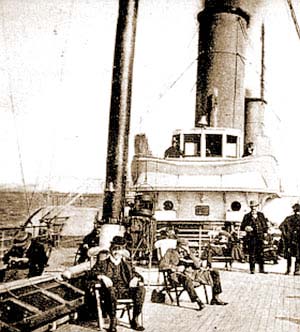
Op donderdag 14 mei 1897 kwam het nieuwe vaartuig te Oostende om 16u00 aan bemand met een Antwerpse bemanning van Cockerill onder bevel van kapitein Cassiers. Ondertussen was het alom bekend hoe mooi en prachtig dit schip was gebouwd. De krant “ l’Echo d’Ostende” had in een publicatie op 7 mei 1897 voorheen al een heel gedetailleerde beschrijving gegeven. Deze hebben we als volgt vertaald en geeft ons een rondleiding:
"Cockerill heeft reeds meerdere luxe pakketboten gebouwd voor de Belgische Staat. We kennen de installaties van de Marie-Henriette en de Rapide. Op dit vlak breekt de Princesse Clémentine alle records. Het is een opmerkelijk absolute smaak en rijkdom en we geloven te mogen zeggen dat het onmogelijk is om nog meer luxe en comfort te creëren op gelijk welk passagierschip.
De Princesse Clémentine is uiterlijk gelijk aan de Marie-Henriette waarvan het we het groot succes herinneren waarbij ze op de Clyde in 1893 alle records heeft verbroken en een snelheid van 22.2 knopen haalde op de testen. De Princesse Clémentine haald bijna gelijke resultaten in echter zeer moeilijke en ongunstige weersomstandigheden. Sterke wind en regen wat de zichtbaarheid beperkte. Het is dus zeker dat de snelheid van de Marie-Henriette zal verbroken worden door de nieuwe pakketboot en deze de snelste op de lijn zal zijn.
Ze heeft de volgende afmetingen: Lengte over alles = 107.36 m - op de waterlijn 103.68 m. Breedte = 11.58 m – over de tamboeren = 23.71 m. Hoogte tot aan het wandeldek = 7.09 m.
Het schip is volledig in zacht staal gebouwd. Ze heeft drie dekken en een commandobrug waarop de reizigers bij mooi weer zullen toegang krijgen. Dit is een nieuwigheid waarbij de reizigers twee wandeldekken bij elkaar krijgen. Het binnendek is vooraan ingericht voor de bemanning en voor de reizigers 2e klasse. Verder zijn de salons en slaapgelegenheden voor de reizigers van 1e klasse. Op te merken valt dat de bedden boven elkaar zijn gebouwd zodat de capaciteit is verdubbeld tegenover de andere schepen.
Op het hoofddek vooraan zijn de hutten voor de dienst en achteraan het damessalon en restaurant 1e klasse. Het damessalon ingericht in Louis XV stijl. Een kleine pracht met goede smaak. De wanden en plafond zijn in citroen panelen omkaderd met groene lijsten. Met artistiek op doek geschilderde panelen. De schouw is in zwaar citroen hout mooi gesculpteerd en draagt een mooie buste in brons. Alles bemeubeld, tafels, stoelen, zetels in citroenhout en gestoffeerd. Achteraan deze mooie boudoir is een radiator die in de winter dit deel met stoom verwarmd. Ze is verborgen achter een bronzen scherm dat heel uitgevouwd een pauw uitbeeld. Het oog van elke pluim bestaat uit een kristal waarachter een kleine elektrische lamp van 4 a 5 volt brand. Het effect is schitterend.
De bemeubeling en decoratie van de damesboudoir waarvan we spreken is uitgevoerd door het huis Snyers Rang uit Brussel. Die werkelijk een meesterwerk hebben gemaakt.
De damesboudoir 1e klasse is naar beneden met een dubbele trap. De wandpanelen en plafond zijn in het roze geschilderd en afgezet met goud. De meubels, zetels, stoelen en poefs zijn in rood velours en gemerkt met de naam van Princesse Clémentine. Achter het damessalon zijn er nog toiletten en andere faciliteiten.
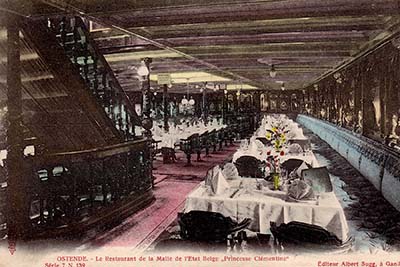
postkaart van het reaturant (collectie A. Goethaels)
Het restaurant is groter dan deze van de Marie-Henriette. Ze is 20 meter lang en kan tot 112 personen installeren aan tafels met rondom kleine gepaste stoelen. Hierbij zonder te rekenen op de zetels die de zaal volledig versieren. Als decoratie en bemeubeling bevat het restaurant een zekere stijl. Het grote succes van alles aan boord van de Princesse Clémentine laat een enorme bewondering toe. Het is werkelijk een stijl Francçois I. De Franse renaissance. Een ruimte met kolommen in gepolijst hout en Italiaans notenhout doen de koperen figuren van grote mannen zoals Francois I en Charles Quint mooi uitkomen. Men heeft voor gepolijst hout gekozen omdat dit het minst gevoelig is voor zeelucht. Het plafond is in lichte kleuren groen en goud geschilderd. De tafels zijn gedekt in met een blauw gebordeerd kleed en op de vloer is tevens een blauw luxueus tapijt. Voor de venster kleine groene gordijnen van een kleur dat heel mooi past bij de blauwe tafels, tapijt en plafond.
Onderaan de grote trap, die een deel is van het wandeldek en anderzijds een deel van de 1e klasse heren, is er een zeer mooi zicht op een paneel dat geschilderd is met een portret van de Prinses die haar naam aan het schip heeft gegeven.
Het binnenvallend licht verlicht aangenaam het restaurant. Achteraan deze is de schouw in brons. Een bewijs van meesterlijke studie. Tussen de kolommen en voor het glas staan een reeks vazen in oud zilver met bloemen en planten. In ‘t kort het restaurant is nog mooier ingericht dan deze van de Marie-Henriette en doet eer aan het huis van Luycks uit Antwerpen die hieraan zijn meestrelijke hand heeft gelegd.
Het eerste wandeldek is voorzien van een afdak waaronder 12 hutten, een rooksalon en een luxe hut. Zeg maar Koninklijke hut. Er zijn 8 grote hutten met twee bedden en 4 kleine met één bed. De grote hutten zijn aangekleed met elk twee aquarellen met landschappen gemaakt door de bekende Mr. Heins uit Gent. Het rooksalon is soberder en is versierd met panelen van meesters met zichten van Spa, Durbuy, Luik, Houffalize, Laroche, Brussel en Bouillon. De schilderijen zijn met glas beschermd. Men heeft toegang tot het rooksalon via een gang die de ganse ruimte goed verlucht.
De grote luxe hut is in een Louis XVI stijl. We merken overal rond de wandtapijten van Gobellins uit Parijs en beelden een landschap op de buiten uit nabij een kasteel. Deze tapijten zijn een ware schoonheid. De meubels van de Koninklijke hut en de grote hutten zijn prachtig. De twee hutten zijn gescheiden door een glazen wand en schuifdeur. De wanden zijn rijk verzorgd door het huis van Franck uit Antwerpen. De hutten, het rooksalon, de luxe hutten, het damessalon, het restaurant, met andere woorden alle ruimten die voor het publiek toegankelijk zijn, is door middel van elektriciteit verlicht en met stoom verwarmd.
Voor het hoger personeel heeft de commandant een hut op het brugdek die slechts met één deur toegankelijk is. De officieren mecaniciens zijn gehuisvest op een dek bij de machine en de luitenanten in het salon van 2e klasse. Van het buiten wandeldek is een deel gereserveerd voor het commando en is zowat 7 meter boven het water.
In het midden van het schip is een kolossale machine. Dezelfde als de Marie-Henriette maar met meer kracht. Ze ontwikkeld zo’n 9300 PK. Acht boilers die de stoom opwekken en zestien aandrijfmotoren die de techinsche installatie voledig maken. Eén van hen drijft de dynamo aan die elektriciteit opwekt voor het ganse schip.
We hebben de rijke details van de Princesse Clémentine kunnen beoordelen wat een toename is comfort en snelheid tegenover de andere schepen van de staatsvloot. Ze is werkelijk prachtig gebouwd. We zijn er ook zeker van dat de nieuwe stomer nog meer zal bijdragen aan de gloofwaardigheid en reputatie van onze exellente Oostende-Dover lijn. Andere andere kant opnieuw een kroon op het werk voor de Cockerill scheepswerf. De staat noch anderen dienen zich nog in het buitenland tot andere scheepswerven te wenden. De Belgische industrie met aan de kop de werf van John Cockerill kan aan alle opdrachten gevolg geven en perfecte producten afleveren."
Na heel wat bewondering kon de Princesse Clémentine op woensdag 2 juni 1897 om 11u00 haar eerste reis naar Dover doen. Koning Leopold II was naar Engeland vertrokken voor het 60 jarig jubileum van Koningin Victoria en was met de Princesse Clémentine teruggekeerd. Zaterdagmiddag 5 juni is hij in Dover ingescheept op de Princesse Clémentine en heeft plaats genomen in een van de luxe hutten in afwachting op het Koninklijk salon. Hij is omstreeks 15u00 in Oostende aangekomen na een overtocht van 2 uur en 58 min. De Koning was vergezeld van Graaf John d’Outremont, groot maarschalk van het hof en baron Goffinet, intendant van de civiele lijst. Zodra de 228 reizigers ontscheept waren heeft de Koning onder begeleiding van dhr Lecointe en Pierre en in afwachting op de trein, een gedetailleerd bezoek aan alle delen het schip gebracht. Enthousiast en met lof voor de installaties van de pakketboot die onlangs de werf van Cockerill heeft verlaten. Onze vorst luisterde zeer aandachtig naar de uitleg gegeven door dhr Lecointe en wilde alles zien. Zelfs de enorme machinekamer. Vooraleer te vertrekken nam hij nog een thee in de Koninklijk hut. Na bijzonder alle functionarissen te hebben bedankt die hem hebben begeleid is hij ontscheept en heeft zich naar zijn wagon begeven die aan de trein Oostende-Wenen was aangehecht. Hij onderhield zich enkele momenten met de heer Groenen, stationchef Oostende en nam plaats in de trein die snel vertrok onder directie van dhr Cuissart, inspecteur generaal van de spoorwegen en dhr Hubert, chef gard.
De Princesse Clémentine was in dienst tot bewondering van allen. De zaterdag 12 juni 1897, en dus nog maar een grote week in dienst, liep de Princesse Clémentine in Dover al schade op. Bij het achteruit varen en aanmeren in Dover werd het roer met geweld tegen het achterschip geslagen waardoor het beschadigd werd. Op de terugreis naar Oostende en bij het manoevreren aan de stroombank, liep het schip vast. De schok was hevig waardoor er enkel passagiers ten val kwamen. Het schip moest al terug naar het droogdok om de schade vast te stellen en te herstellen. De oorzaak was gekend. Er moest dringend iets gedaan worden aan de diepgang in de haven. Het aanslibben was een probleem. Het werd kwasi onmogelijk om nog veilig met laag water op de haven te komen. Zelfs de jachten liepen vast.
Op zaterdag 21 augustus 1897 werd de Princesse Clémentine vanuit Engeland ter beschikking gesteld aan de Koning van Siam. Die was op doorreis naar Duitsland. De Belgische regering was trots op dit schip. In oktober werd het ter berschikking gesteld aan de Burgemeesters en afgevaardigden van de Duitse Kamer van Koophandel die een excursie naar Antwerpen maakten. Er waren zo’ n 500 mensen naar schatting. Op donderdag 20 oktober vertrok de Princesse Clémentine met commandant Borgers richting Antwerpen. Er werd uitbundig getoost en aan de relaties gebouwd terwijl het schip op volle vaart op de Schelde een snelheid van 22 knopen haalde. En beter manier van netwerken kon niet en de promotie voor de Oostende-Dover lijn was uiteraard meegenomen.
Op donderdag 31 maart 1898 vond de Princesse Clémentine ter hoogte van de South Goodwin een witte mast die enkel meters boven het water uitstak. Tevens dreven er een groot aantal wrakstukken in het rond. Men vermoedde dat het om loodsboot 3 ging.
Het was woensdag 28 augustus 1898 wanneer het mis ging met de Princesse Clémentine. De maalboot was rond 14u30 op de terugreis uit Dover wanneer zich een schok voordeed ter hoogte van de Ruytingen en de machines stil vielen. Het stuurboord wiel werd volledig verwrongen de tamboer beschadigd door een ongekende oorzaak. Men kon enkel vaststellen dat de aandrijfas gebroken was. Heel langzaam kon het schip verder en diende op de voormast noodsignalen te dragen. Er werd een sleepboot uitgestuurd ter hulp om deze naar Oostende te brengen. Met een uur vertraging kwam het schip langzaam op sleep in de haven. Er waren 250 reizigers aan boord. Gelukkig waren er geen gekwetsten. Het schip was echter een tijd buiten dienst. De aandrijfarm van de paddels was de zwakste schakel van de stomers in die tijd. Vele malen dienden de schepen om die reden uit dienst te gaan en de aandrijfas vervangen. De krachten die door de motor op de wielen nodig waren was enorm. Een paddelwiel had een diameter van 6,80 meter. Ze had negen schoepen van elke 5.572 breed en 1.321 m. hoog. De as die de paddels aandreef had een diameter van 50 cm met een holle binnenkant van 20 cm. Bij de herstelling werd deze verzwaard met een kleiner midden van slechts 10 cm. De prijs van streven naar hoger snelheid en motorprestaties en krachten.
De Princesse Clémentine legde de kroon op de goede reputatie van de Oostende-Dover lijn. De lijn bestond uit 9 prachtige comfortabele en snelle stomers. Eind augustus 1899 bracht de administratie dan ook een speciale reeks postkaarten uit getekend door P.J. Claeys. De postkaarten kostten 5 cent voor het binnenland en 10 cent voor het buitenland. Er waren twee ontwerpen voor elke waarde. Voor elk schip dus vier poistkaarten en totaal 36 voor de ganse vloot. De postkaarten waren enkel verkrijgbaar op het schip zelf dat de naam droeg.
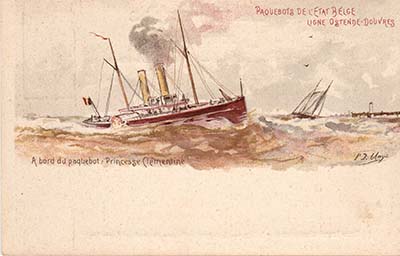
In augustus 1900 was de Perzische Shah Mouzaffer-ed-Dine in de contreien en had de wens geuit om een excursie met de Princesse Clémentine te willen maken en de maalboten te bezoeken. Het Zeewezen stelde uiteraard de Princesse Clémentine ter beschikking en bood hem een excursie aan op zee. Die had plaats op donderdag 16 augustus in de namiddag en duurde een half uur. Commandant Romyn en zijn luitenanten Laroye en Grayet mochten de Shah en zijn gevolg ontvangen. Voor éénmaal voerde de Princesse Clémentine de vlag van Perzië in de mast met aan boord heel wat hoogwaardigheidsbekleders. Het ganse gebeuren werd met de grootste zorg voor de pers afgeschermd. Achteraf heeft de Shah commandant Romy onderscheiden met de Kruis van de orde van Zon & Leeuw.
In de loop van de nacht van zondag op maandag 26/27 augustus 1900 merkte de commandant Vande Kerckhove van de Marie-Henriette ter hoogte van het lichtschip Ruytingen een verlaten Frans schip op. De B1801 had een gebroken voormast. De cdt signaleerde dit aan de maritieme autoriteiten. Wanneer comandant Romyn echter het verlaten schip met de Princesse Clémentine passeeerde meende hij dat deze heel gevaarlijk lag met gevaar voor de scheepvaart. Hij stuurde luitenant Laroye met drie matrozen aan boord om het uit de vaarroute te halen. Het zou onvoorstelbaar zijn dat een maalboot met een snelheid van 40 km per uur het verlaten schip zou aanvaren.
Dat jaar was het Zeewezen al bezig om op de vaartuigen het Marconi systeem te voorzien. De overheid had aan de jonge onderneming van Marconi toelating gegeven om proeven te doen. De Princesse Clémentine was het eerste schip waarop een station zou worden geplaatst. Eind oktober 1900 had men vernomen dat de Marconi installatie voor het schip uit Dover zou worden verscheept. Aan de Belgische kust in De Panne had een ploeg van de Genie de zendapparatuur geplaatst die communicatie met de schepen op zee zou verzorgen. Een telegrafiepost omvat een zendpost en een ontvangpost. Zowel aan land als op zee. Men koos voor De Panne voor zijn ligging en de lage prijs voor het terrein. De afstand tussen De Panne en Dover is zo’n 115 km.
Dit was het prille begin en uiteraard geen sinecure. Een post aan de wal had een zendmast van 46 meter hoog. Bovenaan diende deze mast een gewicht van 30 kg te kunnen dragen. Het toestel bovenaan was verbonden met twee draden. Eén ervan liep naar de grond (aarding) en de andere moest met een sterke stroom naar de apparatuur gestuurd. In het gebouw waar de zender/ontvanger stond werden 8 batterijen van 16 volt – 16 ampère geplaatst die via een Ruhmkorffspoel naar een hoger spanning van 40 000 volt werd omgezet. De batterijen werden door een dynamo in het gebouw geladen. De antenne waren drie draden samen gesoldeerd en totaal zo’n 60 meter. Naargelang de hoogte van de mast kon zo een afstand van 300 km worden overbrugd.
In De Panne was de zendinstallatie begin november 1900 al klaar. Aan boord van een schip moest zich uiteraard ook een Marconi ontvangsttoestel bevinden. Op de Princesse Clémentine had men een testopstelling van apparatuur geplaatst. De mast werd verlengd tot 21 meter waarop het Marconi toestel werd geplaatst. De bedoeling was om de ganse winter testen te doen. Ten minste gedurende vier maanden. Vanuit De Panne moest men de berichten telefonisch doorseinen naar het hoofdbureau in Oostende. Men verwachte dat de berichten over de ganse reis tussen Oostende en Dover zouden kunnen worden ontvangen. Op zaterdag 3 november 1900 om 17u00 konden de eerste berichten al verstuurd en ontvangen op de Princesse Clémentine die in de haven van Oostende lag. Diezelfde avond konden de ingenieurs gedurende de ganse reis met de Princesse Clémentine berichten versturen en ontvangen. Op de terugreis liet commandant Romyn op zo’n 40 mijl van Oostende aan de stationchef Oostende hun ETA van +/- 03u30 weten. (ETA = Estimated Time of Arrival)
Begin december 1900 deed er zich echter een kleine storing voor. Het was mistig en zeer vochtig waardoor men geen ontvangst had. Een matroos kwam op het idee om de draad in te smeren met vet zodat het vocht er geen vat op had. En ja, de communicatie werd na een tijdje hersteld. De testen gingen nog door tot oktober 1901. Men was overtuigd van het nut en op de Princesse Clémentine ging men een speciale hut bouwen voor een zendstation. Lokaal in de volksmond kwam al gauw de beschijving wanneer men over de Princesse Clémentine sprak van “ Het is de boot met de macaroni ”.
Op vrijdag 7 november 1900 had de Princesse Clémentine in Dover een ongeval. Bij het afvaren in Dover in de dichte mist en met de bedoeling zich verder aan de rede weg van de pier te leggen, zag de officier plots een schip voor zich. Omdat de telegraaf niet direct werkte duurde het even voor het schip kon gestopt. De Princesse Clémentine raakte een Frans schip “Empress” van de Calais-Dover route dat voor de pier aan de rede ten anker lag. De schade was aanzienlijk.
Op 2 januari 1901 ontmoette de Princesse Clémentine op zee een Zweeds vaartuig de “Medora” dat zijn roer had verloren. De Princesse Clémentine kon via het Marconi systeem een bericht sturen waardoor één uur later al een sleepboot ter plaatse was.
Op zondag 20 januari had de Princesse Clémentine om middernacht Dover verlaten. Voor Oostende was er een dikke mist en het schip liep om 03u00 vast voor Mariakerke. Met een telegram kon onmiddellijk sleepboothulp worden gestuurd. De sleepboot kon echter niet bij de Princesse Clémentine wegens het lage water en diende te wachten op het getij. Het schip kon om 09u00 worden aangemeerd. Door het voorval was het roer gebogen en diende het schip naar Antwerpen voor herstelling. De donderdag 24 januari vertrok de Princesse Clémentine om 17u00 naar Antwerpen voor de herstelling. Op de rede kwam ze echter in contact met een stomer uit Grimsby de “Ashton”. Beide schepen liepen licht schade op. Na enkele weken herstelling was de Princesse Clémentine op 21 februari terug in Oostende.
In het budget van 1902 moest de overheid nog de kosten voor het Marconi systeem opnemen. De testen waren uitstekend en men wilde de installatie aan boord van de Princesse Clémentine definitief maken. Hiervoor had men een som van 156 400 Fr. aangevraagd. Daarin zat een bedrag van 135 000 Fr. voor de aankoop van een nieuwe Marconi zendinstallatie. 3400 Fr. voor de speciale hut geplaatst op het schip en de rest van 18 000 Fr voor de plaatsing van hutten op de andere schepen. De oppositie vroeg zich echter wel af of de keuze voor Marconi wel terecht was. Ondertussen waren er al andere en betere systemen uitgevonden. De regering had echter verkozen voor Marconi op alle negen schepen van de lijn. Tegen september 1903 waren alle negen vaartuigen uitgerust met een zendstation. Reizigers konden ook van de communicatie gebruik maken en deden dit dan ook gretig.
Aan boord van de Princesse Clémentine was Gustaaf Sorel de eerste marconist. In een periode van 15 maart tot 1 oktober 1904 waren er al 1323 bijzondere telegrammen tussen de pakketboten en Nieuwpoort uitgewisseld.
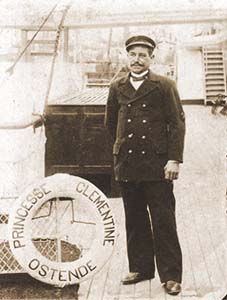
Foto Gustaaf Sorel marconist aan boord van de Princesse Clémentine.
Op maandag 26 juli 1903 was de Princesse Clémentine om 11u00 pas vertrokken toen ze ter hoogte van de Koninklijke Chalet stil viel. Commandant Fourcault diende noodsignalen uit te sturen om sleepboothulp te vragen. De schade was eigenlijk niet zo erg. Een stang van de lage druk was geplooid. Het schip kon snel worden binnen gesleept en de 300-tal reizigers op de 15u00 afvaart ingescheept. Gelukkig was een reservestuk voorhanden en kon de technische dienst het euvel terug herstellen. Uiteraard was er op deze zomerse dag vanop de dijk in Oostende enige commotie om het schip daar hulploos te zien liggen.
Het succes van de Princesse Clémentine was duidelijk. Telkens kozen Royals en belangrijke mensen te reizen met dit prachtige schip en uithangbord van de Oostende-Dover lijn. Toch was het dringend nodig om tegen einde september 1905 het schip naar Antwerpen te sturen voor een grondig onderhoud en droogdokbeurt. In 1906 diende men al een som van 220 000 Fr in de budgetten 1907 te voorzien om twee boilers van de Princesse Clémentine te vernieuwen. De hoge snelheid en geëiste prestaies van de motoren waren uiteraard onderheven aan slijtage. De Princesse Clémentine haalde samen met de Marie-Henriette en de Léopold II een gemiddelde overtocht duur van 3u en 29 minuten. Een overtocht kostte gemiddeld 1482,80 Fr. De snelste maalboot in 1908 was uiteraard de Princesse Elisabeth die er gemiddeld 3u 10 minuten over deed voor een reis naar Dover.
Eind oktober 1908 had de Princesse Clémentine bij het invaren bij dichte mist het staketsel geraakt en het voorroer gebroken. Hierdoor was ze buiten dienst maar stond al op de planning om naar Antwepren te vertrekken voor jaarlijks onderhoud en herstellingen aan de boilers. De werken zouden één maand gaan duren en de kost was geraamd op 250 000 FR. In die periode deed het Zeewezen de eerste proeven met een gemotoriseerde reddingsboot. De boot was 12 meter lange en aangedreven met een 30 PK 4 cilinder motor.
In juni 1910 had de Princesse Clémentine een aanvaring met een schoener in Dover. Beide schepen werden licht beschadigd. Er ware zestig reizigers aan boord die met zo’n 3 uur vetaging te Dover aangekomen zijn. De commandant van de Princesse Clémentine had gewacht tot alles veilig was met de aangevaren schoener.
Op donderdag 22 oktober 1911 was de Princesse Clémentine inn Dover wanneer er op de Admiralty pier een brandweerman in zware weersomstandigheden plots door een windstoot werd verrast en in het water viel. Matrozen Sweetlove, Maertens en Blondé bleven niet toekijken en zetten onmiddellijk een boot uit op de man te redden. Later in februari werden de helden van de Princesse Clémentine in Dover door de burgemeester ontvangen en onderscheiden.
Op vrijdag 24 januari 1913 kwam de Princesse Clémentine in aanvaring onderweg naar Dover. Ze was rond 18u00 aan Dover en kwam in aanvaring met een Noors schip de “Heimdal” die onderweg was naar Port Natal. De bemanning van 19 en één vrouw kon gered. Luitenant Meyer en matroos Blondé va de Princesse Clémentine zijn echter verdronken.
Die vrijdag was de Princesse Clémentine om 15u30 uit Oostende vertrokken. De zee was nogal wild en om 18u00 ter hoogte va de Ruytingen zag de uitkijk plots een driemaster voor. Een aanvaring kon niet vermeden en de Princesse Clémentine boorde zich in het ship. De driemaster werd zwaar beschadigd en was bewust dat het schip ging zinken. De Princesse Clémentine was ook zwaar beschadigd. Het roer en de romp vooraan waren beschadigd. De bemanning van de Heimdal zette onmiddellijk de boten uit om zichzelf in veiligheid te brengen terwijl ook de Princesse Clémentine een reddingsboot buiten zette en ter hulp ging. De reddingsboot van de driemaster kon langszij de Princesse Clémentine komen.
De Heimdal was geladen met hout voor Port Natal in Zuid-Afrika. Op het moment van de aanvaring gaf de commandant van de Princesse Clémentine onmiddellijk bevel achteruit te slaan. Op datzelfde moment sprong luitenant Meyer met enkele matrozen in een reddingsboot en zette die buiten zonder de commandant te verwittigen. Wanneer de reddingsboot in het water landde draaide het wiel van de maalboot achteruit en deed de reddingsboot omdraaien. Dat wierp de inzittenden in het water. Men uitte een kreet van paniek en begon snel hulp te bieden. Men kon nog twee matrozen veilig binnen halen terwijl men de andere twee niet kon bereiken. Men hoorde nog hulpgeroep maar na enige tijd werd het stil en luguber. Een hele tijd zoeken bracht niets op. De slachtoffers waren de 24 jarige Luitenant Arthur Meyer, geboren in Vlissingen en de 25 jarige matroos Oscar Blondé, geboren in Adinkerke. Deze laatse was nog maar pas enkele dagen vader geworden. De moedige mensen hadden prompt gereageerd op de noodsituatie maar de commandant was echter niet ingelicht.
De beschadigde Heimdal bleef nog drijvend op zijn lading hout en kon later aar Duinkerke gesleept. Achteraf op 25 januari werd het schip geborgen en de lading op een Russische driemaster overgeladen. De Princesse Clémentine vertrok die dag ook naar Antwerpen voor herstelling. Achteraf werd de familie van Lt Meyer en matroos Blondé wegens hun heldhaftige daad bij beslissing van de Carnegie Foundation het pensioenbedrag dat ze door de staat werd toegekend verdrievoudigd. Ook werkman Laforce, die gewond werd bij dit ongeval kreeg een vergoeding.
In de zomer van 1914 begonnen de mensen te vluchten en kozen voor de overzet naar Engeland. De eerste vluchtelingen kwamen al aan in Oostende op 11 augustus. Dagelijks vervoerden de maalboten vluchtenden vanaf augustus naar Folkestone. Het was vooral de Léopold II en de Marie-Henriette die dagelijks één reis ondernamen en de Princesse Clémentine fungeerde als ondubbeling. De andere schepen hadden heel wat werk om de goud- en geldvoorraad weg te halen en Antwerpen bij te staan.
De Princesse Clémentine werd ingezet op zaterdag 23 augustus 1914 met het Rode Kruis om de eerste gewonden te vervoeren. Die namiddag werden gewonden uit Brugge naar Oostende vervoerd met de ambulance van Stracké aan boord van de Princesse Clémentine gebracht. De Princesse Clémentine is dan vertrokken met commandant Coucke, dokters en verplegers aan boord in een richting veiligheid afwachtend op meer nieuws. De maandag was commandant Coucke al druk bezig met het bevoorraden en opslag van kolen om de 280 gewonden aan boord te verzorgen. De Belgische gewonden bleven op het dek en de Duitse gewonden zaten in de hutten 2e klasse. De maalboot van dinsdag 25 augustus vertrok om 10u47 naar Folkestone.
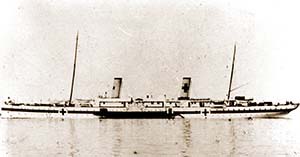
De maalboten hebben veel bijgedragen bij de evacuatie van de bevolking. Startend in september in Antwerpen en de daarop volgende maand oktober weghalen van vluchtelingen uit Oostende. Vanaf het begin van de oorlog en dit tot 15 april 1915 nam de Princesse Clémentine deel aan het vervoer naar Franse havens van gewonden afkomstig van de Westhoek. Hiervoor werd ze omgebouwd naar hospitaalschip volgens de conventie van Den Haag van 18 oktober 1907. In die periode maakte ze 15 reizen en vervoerde zo’n 4503 gewonden afkomtig van het Ijzerfront. Daarna werden de schepen overgemaakt aan de Britse Admiraliteit om als hospitaalschip en transport van troepen te fungeren. Princesse Clémentine was vanaf 19 november 1915 ter beschikking van de Britse Admiraliteit en deed tot eind december 1918 344 reizen over het kanaal waarbij 649 533 soldaten werden vervoerd en militaire hulp geboden. Deze reizen waren onder militaire begeleiding van destroyers en begleidingsvliegtuigen om evetuele duikboten op te sporen. Na de oorlog vanaf januari 1919 repatrieerde de Princesse Clémentine nog Britse troepen en kwam ze in mei 1919 terug naar België om te worden hersteld en voor de normale lijndienst terug beschikbaar te zijn.
In de eerste dagen dat de schepen na de oorlog terug de reis naar Dover maakten, was dit heel voorzichtig en vaarden de schepen steeds langs de kustlijn zodat het land altijd in zicht was. Slechts ter hoogte van Calais staken ze recht over naar Dover om zo de kortste afstand te kunnen nemen. De reden hiervoor was omdat er nog altijd drijvende mijnen aanwezig konden zijn. In geval van ongeval was het schip niet ver van de kust en de kans voor de opvarenden groter. Vanaf mei 1920 waren er terug twee afvaarten per dag in beide richtingen. Het in en uitvaren van de haven werd bemoeilijkt door de aanwezigheid van het wrak van de Vindictive. In augustus 1920 werden op 14 en 15 augustus 1920 de werken gestart om het wrak van de Vindictive te verwijderen. Op het moment van de werken was de haven ontoegankelijk en diende de maalboten uit te wijken naar Zeebrugge. Op 17 augustus werd terug groen licht gegeven en was de haven van Oostende terug toegangkelijk. Het kostte heel wat inspanningen om de oorlogschade te herstellen alsook de Oostende-Dover lijn terug volledig operationeel te krijgen. In 1913 haalde de lijn nog 254 169 reizigers. In 1919 was dat 161 226 en in 1920 konden al terug 265 633 reizigers worden vervoerd. De Oostende-Dover lijn stond politiek onder druk en er gingen er stemmen op om de lijn te sluiten wegens verlieslatend.
Met de komst van de nieuwe turbineschepen zoals de Jan Breydel, Pieter de Coninck, Ville de Liège en de in opbouw zijnden Princesse Marie José bleef de Princesse Clémentine als reserveschip fungeren vanaf 1923. Pas in 1928 werd ze verkocht aan een Frans bedrijf uit Duinkerke voor de sloop.

